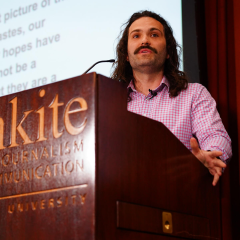Since 1918, when America celebrated the armistice ending WWI, November 11 has been an important day in the United States. It became even more notable in 1954, when President Eisenhower declared it a Federal holiday honoring all American veterans. Here are three business stories to pursue.
Is it really a holiday?
Along with Columbus Day, Veterans Day is the rare Federal holiday unobserved by much of the private sector. On holidays such as Thanksgiving, Christmas, Labor Day, Memorial Day and Independence Day—as well as non-holidays like Black Friday and the day after Christmas—more than 90 percent of offices are closed. On Veterans Day, only 19 percent of workplaces keep the shades down.
According to Gail Perry, a member of the State Council for the Arizona Society for Human Resource Management, a growing number of businesses offer fewer traditional holidays, and more “floating holidays” and personal days. She says employees like having choices in the days they take off.
Post-9/11 veterans seem to prefer this flexibility, while older veterans who served in WWII, Korea, and Vietnam tend prefer traditional holiday observances. The Commander of the Arizona Veterans of Foreign Wars, Ken Marshall, says veterans served to protect everybody’s rights—including private companies’ rights to observe or not observe Federal holidays.
Find out what HR departments in your community do for holidays. Are they leaning towards more flex-time and floating holidays, or do they observe a traditional holiday schedule? If they’re remaining open during Veterans Day, are they holding a special ceremony or observance?
Not everyone loves free meals
Dozens of restaurant chains offer free meals to active military, veterans and their families on the holiday. Although many people appreciate these gestures, they’re also good for a restaurant’s bottom line. The cost of free meals is often outweighed by the ancillary revenue restaurants accrue as veterans bring in their civilian friends (who pay for meals) and order alcohol (which is never free).
Many servers at these restaurants say that Veterans Day is their busiest day of their year. But these servers don’t reap the benefits: When a meal is comped, many people believe they don’t have to leave a tip. So while the restaurant might be raking it in, the staff is working harder for minimal rewards.
Talk to local restaurant managers and servers, and write about how they plan for Veterans Day. What does their schedule look like? How do they plan to handle the increased demand? What do the servers think about the promotions, and how does it affect them?
Comparing salaries and employment
The U.S. Department of Veteran Affairs annually releases a study of veteran employment and education statistics, which offers a lot of insight. According to the 2016 Veterans Economic Communities Initiative (VECI) Pilot Report, more veterans have been exposed to higher education (“some college”) than their civilian counterparts, but fewer have actually graduated. However, not all veterans use their GI Bill benefits for traditional education: Many job training organizations, like commercial trucking schools, police and fire academies, and shipyards accept educational benefits.
From 2010 to 2014, median income for veterans was $37,466, while median income for the non-veteran population was $26,214. In 2015, post-9/11 veterans had a slightly higher unemployment rate than non-veterans.
Outside of government, most veterans are employed in manufacturing, business, retail and education. In your community, what businesses are making strides in employing veterans? Profile post-9/11 veterans in your community to learn the specific employment challenges (and benefits) they’re facing.











